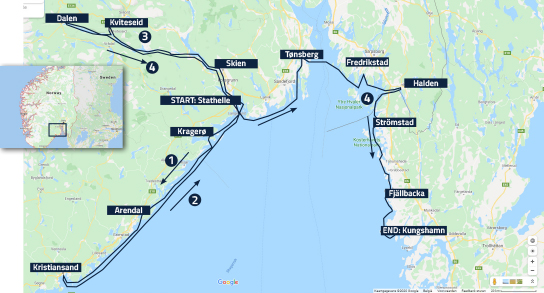- Details
A Summer on a Linssen yacht in Norway
We travelled with our Linssen motor yacht Grand Sturdy 410 AC from Maasbracht (netherlands) to Norway, through Germany, Denmark and Sweden.
Islands and a Canal: A Summer in Norway on a Linssen yacht
In May 2017 my wife and I and our two (long-suffering) long-haired miniature dachshunds, Ross and Sonny, arrived in Maasbracht to start our adventures on board Marylla, our new Linssen Grand Sturdy 410 AC. That first summer was spent with family and friends exploring Holland from Maasbracht to Scharendijke and then to Groningen and back to Maasbracht to overwinter at the Van der Laan yard. The summer of 2018 was a gloriously sunny one and we cruised through Germany along the Mittelland Canal to Poland, eventually following the coast west to Travemünde. Later we sailed from there to Denmark, across to Sweden and finally to Norway.
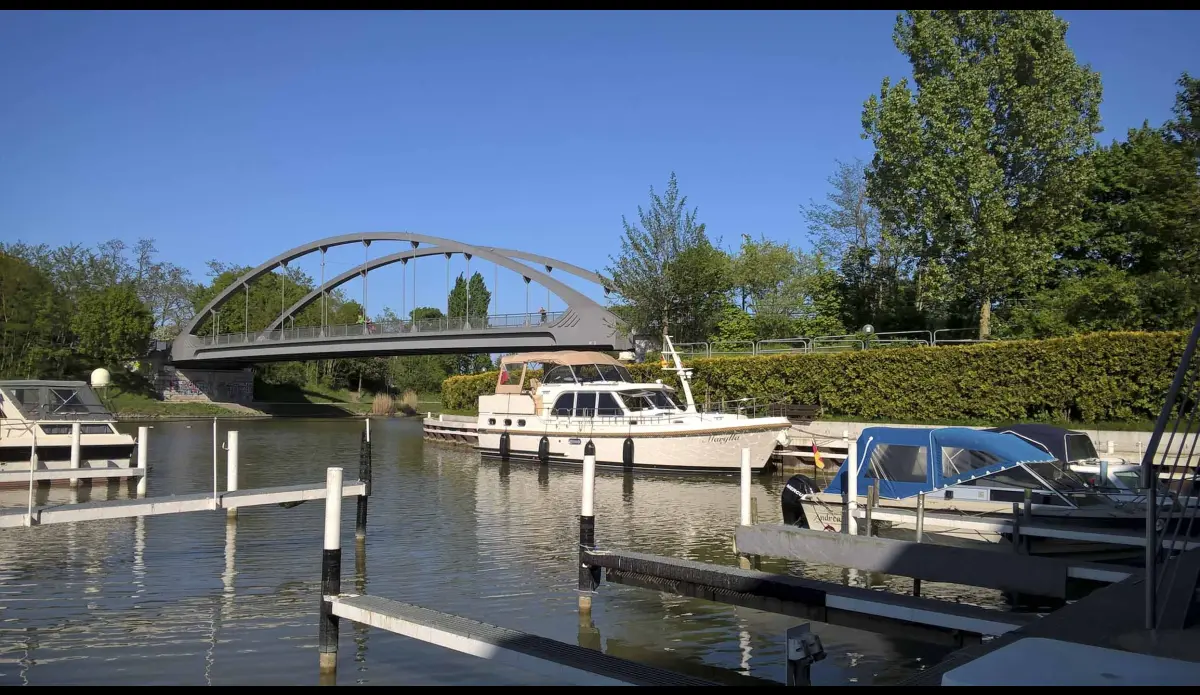
Winter in Stathelle
Marylla spent the winter in the Wector Yachting yard at Stathelle. Our initial plan was to spend a month going south along the east coast of Norway and in particular exploring the Blindleia (Blind Alley) between Grimstad and Kristiansand, a further month exploring the West Coast between Stavanger and Bergen and a final month on the return journey before laying up for the winter of 2019/20 at Kungshamn in Sweden. We accepted from the outset that Marylla was not primarily designed for the open seas so we knew that getting to the West Coast of Norway might not be achievable unless the weather was good enough. Many Norwegians have motor boats, but they tend to be gliders or half-gliders and can do at least 18 knots, which means they can escape bad weather, although the speed limit is generally 5 knots between the islands.
For the first three weeks the weather was variable, but we managed to sail to Kragerø, a very pretty town and then to Risør, the white town, where we stayed for several days in pouring rain. From Risør it was smooth through the islands, but it was quite bumpy when there were stretches out at sea. From there we went through the fjord to Arendal which is a largish town with two alternative moorings: one in the centre of the town and the other in a more exposed marina. At the end of May, we left Arendal for Grimstad, where Henrik Ibsen once lived and then on a lovely sunny day we motored the 20 kilometres through the delightful narrow channels of the Blindleia to Kristiansand. We were fortunate to have 1:50,000 scale charts lent to us by friends. These charts had clear routes marked on them by kind Norwegian friends they had met in Kristiansand the year before. We stayed in Kristiansand waiting for a fair wind and flat sea to enable us to sail around the exposed south coast and then north to Stavanger. Due to strong winds and heavy rain we had to stay there for two weeks and abandoned our initial plans.
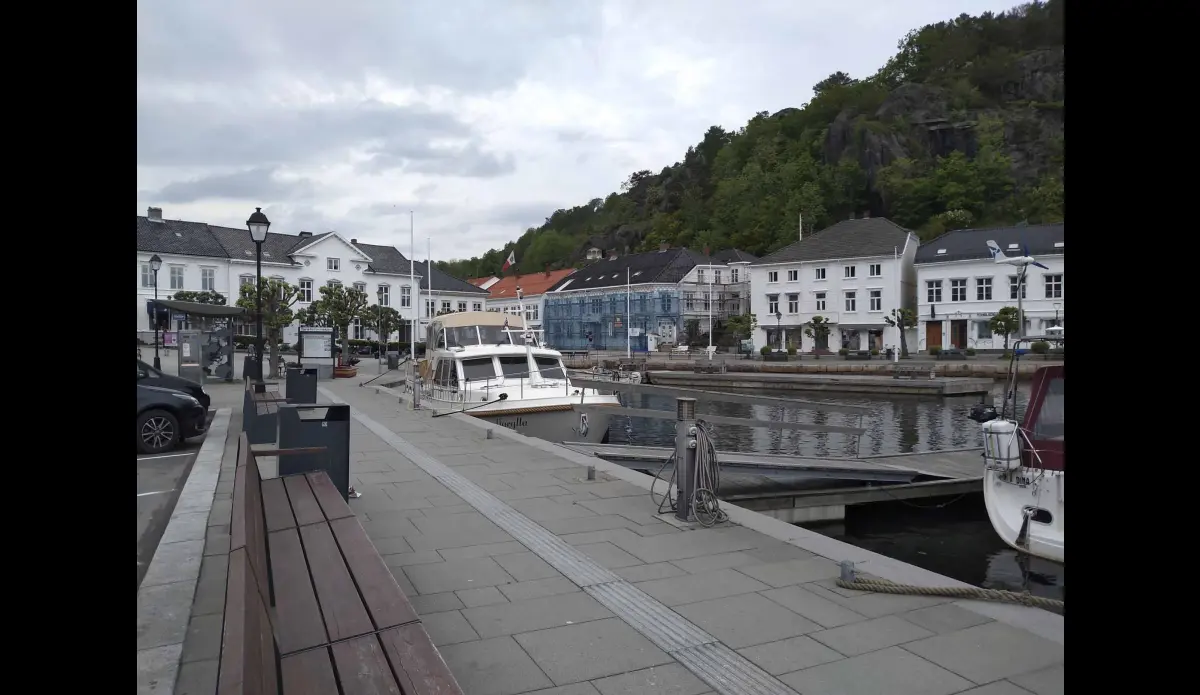
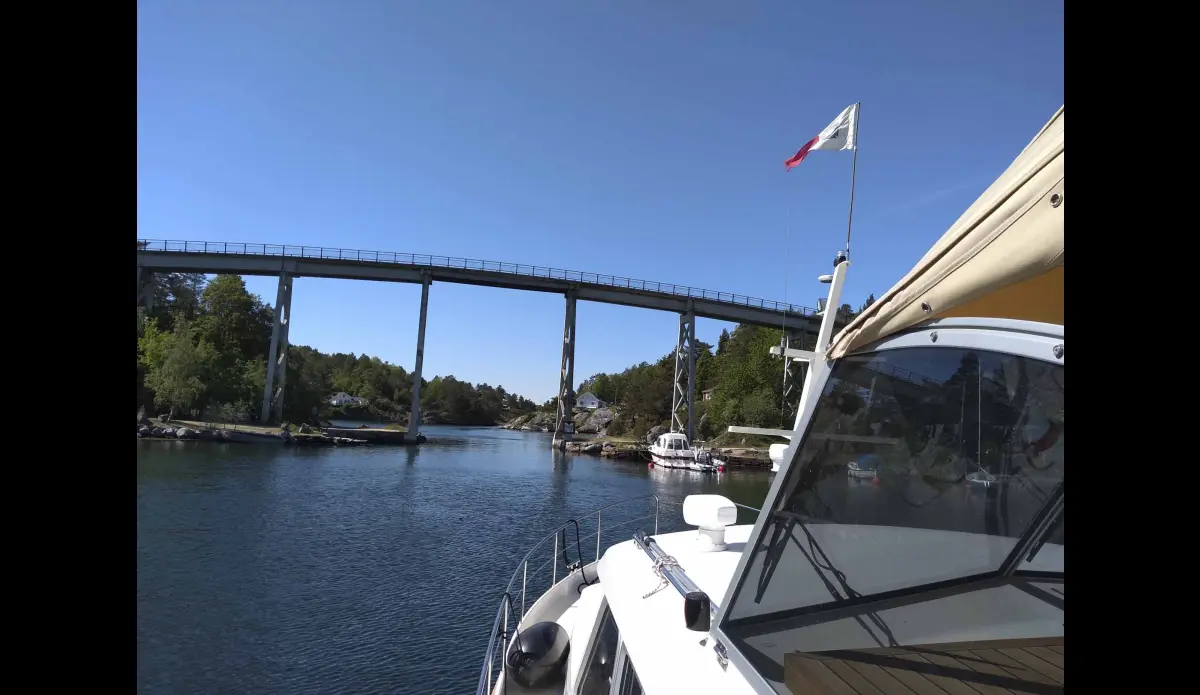
With a Linssen to the Telemark Canal
We therefore turned north and retraced our steps, revisiting Grimstad and Risør, with much greater confidence than on the journey south.
By the end of June, we were back in Stathelle and decided to go up the Telemark Canal. The weather was now quite sunny and although it did not last, the temperature reached 28ºC one day on the canal at Lunde, which was the highest we experienced in 2019.
The Telemark Canal was built between 1861 and 1892 to bring timber down from the mountains. It runs from the town of Skien near Larvik for a distance of 105 kilometres to Dalen in the southern mountains, taking in eight locks involving 18 chambers and three large lakes. The scenery is spectacular throughout and we are told that the northern sector on Lake Bandak is not unlike the Norwegian Fjords on the west coast. The advantage for us with our two dogs was that friends and family who were due to visit would be able to follow a plan without being overly dependent on the weather.
We were one of the larger boats using the canal and whilst most locks were 100ft long, we were pleased when we had a lock to ourselves or with one other boat in front of us, in particular when ascending. All the locks, except one, are manually operated, principally by students, who drop lines fore and aft as boats enter and when there are multiple chambers, they retrieve them and drop them down in the next chamber.
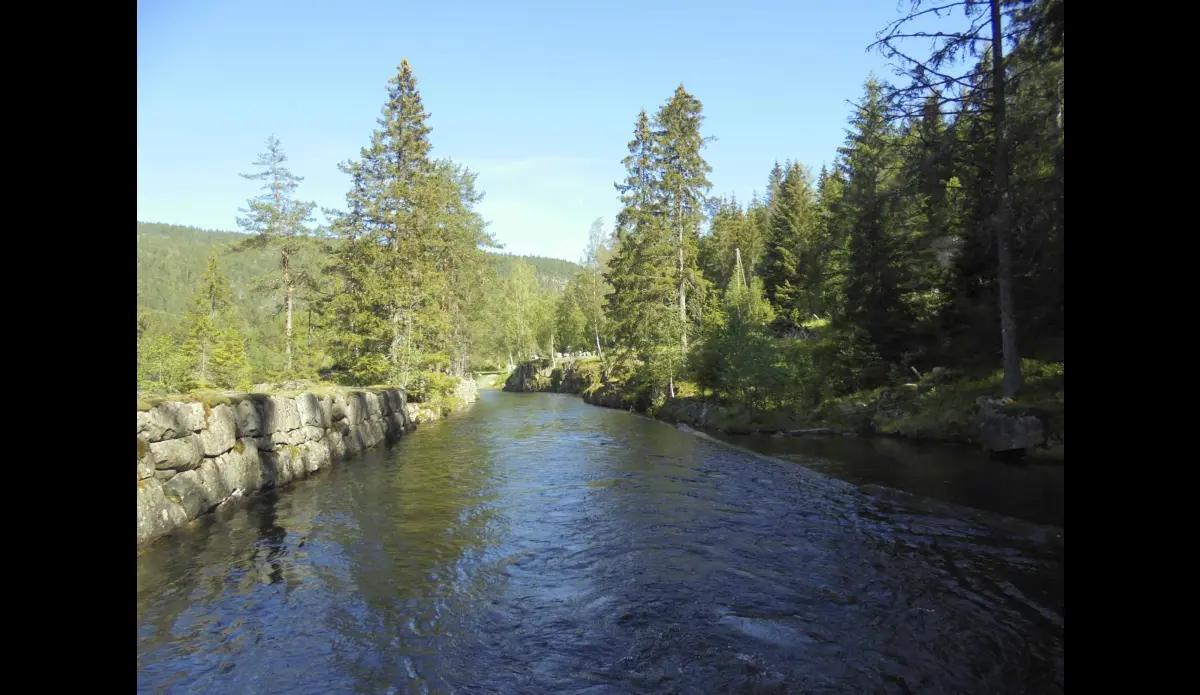
Lake Norsjø reminded us of the Scottish Highlands
We opted for a summer pass at a total cost of about £400 which included all the locks and use of the canal and lakeside moorings and pump-out stations but not, as we later learnt, all the marinas. The canal is only open to private boats from 21 June to 15 August, although the three steamers that ply the canal operate throughout the summer.
Boats with an air draft of less than 12.8m are able to navigate the whole canal and boats with an air draft of more than 12.8m and less than 16m can go as far as the Ulefoss locks and then up the northern part of Lake Norsjø as far as Notodden.
We left the Wector Yard near Stathelle and headed up Frierfjorden to Skien where we entered our first lock, which is the official entrance to the canal and where you buy the pass.
On exiting the lock, we motored a further five miles to the flight of three locks at Skotfoss. The channel was quite narrow in places but clearly marked with topmarks on poles showing which way we had to go. We arrived at the eastern end of the Løveid locks just before 5.00 pm where we decided to spend the night. Shortly after, the bow of the steamer Victoria appeared towering above us in the lock before descending. She was built in 1878 and has been in constant use on the canal ever since.
The next morning was pleasantly warm with little or no wind. At about 9 am we watched the Victoria ascending (now on the upstream journey to Dalen where she arrives about 6 pm). We were called into the lock at 9.30 am, a little fearful as the three flights rising in a narrow gorge looked quite daunting, but in the end we climbed up all three chambers easily, emerging in less than an hour onto Lake Norsjø, a long and attractive lake which reminded us of larger lochs in the Scottish Highlands.
After breakfast we motored the six miles across the lake to Ulefoss, having an impromptu MOB drill en route when our dog, Ross, lost his favourite ball over the side. It was successfully retrieved with the aid of a fishing net and boat hook!
We arrived at the Ulefoss locks and decided to spend the night in the marina and enjoy the sunshine and most importantly, it seems these days, to catch up on emails. Our experience in Norway is that as few marinas have good Wi-Fi connections, the best place to catch up with the world is to find the nearest Co-Op shop.
Viewpoint with lovely views over the mini waterfalls on the rock face
The next morning, we awoke to another lovely day with a flat sea. The forecast was for a hot day and we were pleased that a breeze was likely to pick up as the day went on, which is the norm in this part of Norway.
After breakfast, we decided to pump out the black water tank. As often happens, we didn’t have the right connection between the boat deck fitting and the shore pump but with the help of the bag of spares lent to us by the harbourmaster (who also ran the marina café) we went alongside in less than 1.5 metres of water and managed the pump-out with ease. We still don’t understand why most of the pump-out stations we have come across, both in Norway and elsewhere, either do not work or are inaccessible to all but the shallowest draught vessels. Surely if countries want boat owners to protect the environment and pump out, they should provide the equipment to do so in a place which is reasonably accessible to all potential users. As a result of the time spent pumping out, we did not leave Ulefoss until noon and had to wait at the lock for about three-quarters of an hour while the Henrik Ibsen descended. At all times on the Telemark Canal pleasure boats have to give way to the steamers. Finally, we were called into the first chamber behind a Norwegian Grand Banks type motorboat of about 40 ft with whom we were to stay for all of the locks during the next two days. It was hard work and we were extremely relieved to have the large balloon fenders (at least a metre in diameter) which were lent to us on arrival and which we were allowed to keep until we returned on the downstream journey.
We were through the two flights of Ulefoss by 2.30 pm and then enjoyed a pleasant motor up to the Eidsfoss lock with lunch en route, arriving about 3.30 pm, when we were told we had about an hour to wait for the two Steamers, Victoria and Telemark (the third and smallest steamer) to come through. They arrived about 4.00 pm when we were asked to pull back to give them room to manoeuvre. On exiting the lock, we were told that the crew at Vrangfoss locks would wait for our arrival if we wished to push through that day. We opted to do this and arrived at the five-flight lock at about 5.20 pm, exiting at 6.10 pm.
The next morning, we took a walk to a viewpoint with lovely views over the mini waterfalls on the rock face. We left the mooring late morning and motored the six miles to Lunde lock. The scenery, which was becoming much more mountainous, reminded us of Switzerland. All the way up we had been leaving the white channel markers to starboard and the red to port. Why white? We suspect this is because green markers would blend in too easily with the trees. On arriving at Lunde lock we were told that two steamers (the Victoria ascending and the Henrik Ibsen descending) were about to come through and there were two more boats ahead of us waiting to be lifted. We pulled back so as to allow the Telemark, which stops there, to turn around. It was the one and only time that we came across all three steamers at the same place at almost the same time. There is a good marina next to a campsite on the northern side of the lock where we spent the night. The two supermarkets are about a kilometre away.
Next morning, we left at 10.00 am going into Kjeldal lock, which was open and waiting for us, at 10.15 am. The final lock was the double chamber at Hogga where we arrived at 10.40 am.
We tied up at 11.15 am to the NW of the lock for breakfast and walk the dogs with rain threatening and much cooler than the day before.
Away again by midday and still on the canal, we passed the Victoria heading towards Skien. By 1.00 pm we were halfway down Lake Flåvatn when there were a few short sharp showers. The scenery was very attractive, becoming more dramatic and steep-sided and hills looking more like mountains. The water in the lake was very deep, ranging from 76m to 120m.
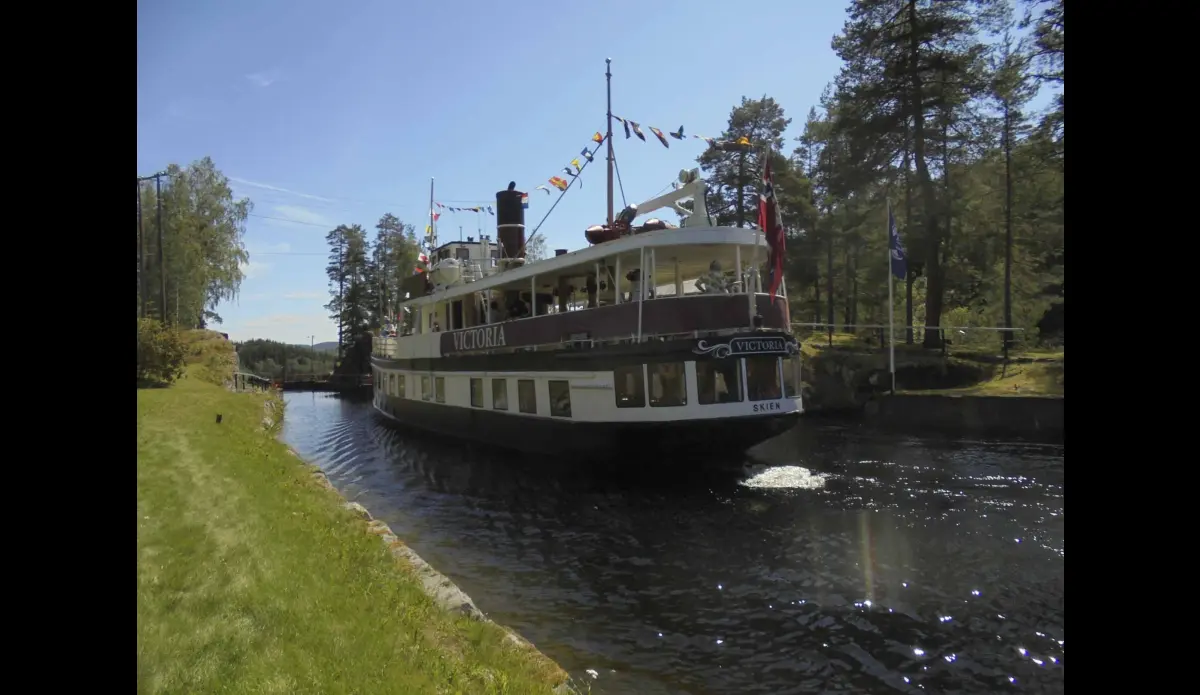
The entrance to Kviteseid
The canal between Flåvatn and Kviteseid is very narrow at its eastern end and at one point it was difficult to see where it went until we were right on top of it.
At the entrance to Kviteseid, where we planned to spend the night, there are two bridges across the channel, the first very high but the second, a swing bridge, had an air draft of 4m. Our air draft is 3.8m with the mast down and I was reluctant to pass under it, especially as the swing bridge was due to open an hour later. When we approached, the lady bridge operator was waiting and opened the road barriers and the bridge for us.
Thereafter it was only a short motor of about half an hour to the marina at Kviteseid where we moored, with some difficulty, with a strong beam wind pushing us off.
The next day, we woke to a sunny but windy morning and so decided to stay put.
Kviteseid is a good place to stay with marina fees at about £15 per night inclusive of water and electricity and with several shops.
After four nights we left Kviteseid and arrived at the swing bridge at 10.45 am, just in time as the morning opening time was between 09.00 am and 11.00 am. We initially thought the bridge operator had gone home but a toot on the horn brought him back and we passed through with waves all round.
Shortly afterwards, we reached the bridge at Spjotsodd. This was the beginning of a long interconnecting channel leading to Lake Bandak. By the time we arrived there, the wind had freshened and the lake was quite choppy.
Despite the wind and spray, it was an easy and enjoyable journey up Lake Bandak, Ross was a little uneasy and sat on Marie-Louise’s lap, but Sonny was much happier and seemed to be finding his sea legs!
At 11.45 am we were abeam of Lardal, which is six miles to the east of Dalen, and decided to stay there for the rest of the day and overnight. It was very quiet, and we were the only boat there. There was no water or electricity but no mooring fee either.
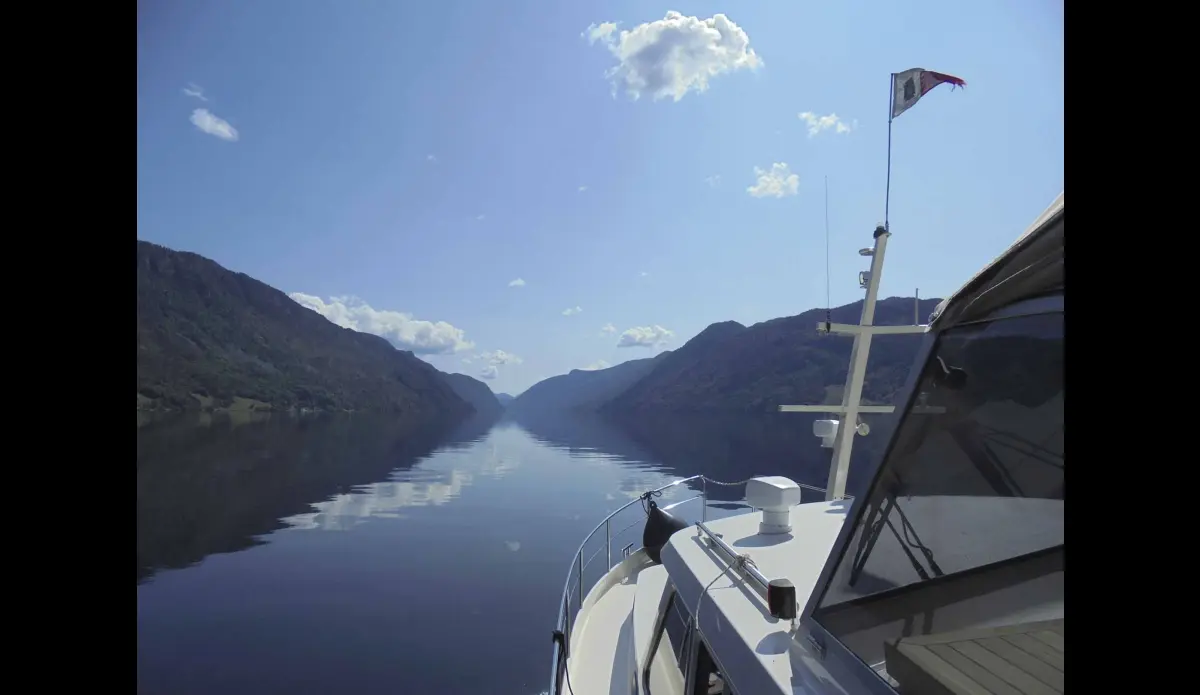
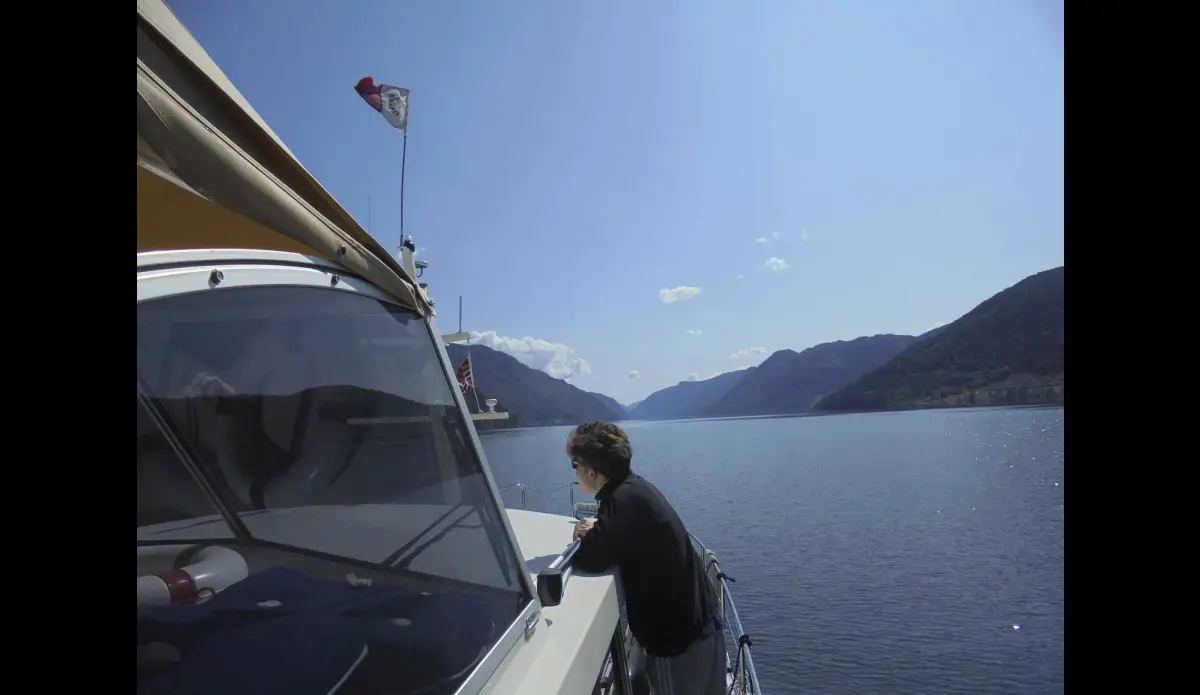
The dogs woke me at 06.15 am the next day to a fine but cold morning with a temperature of only 8ºC. The depth sounder was behaving erratically which I later realised was due to the depth of water on Lake Bandak which at its maximum depth of 325 metres sometimes exceeded the working parameters of our depth sounder. We motored slowly up Lake Bandak at about 5 knots enjoying the weather and the views and arrived at Dalen in about an hour.
Dalen has moorings for about six large boats and several smaller ones, with strong pontoons and cleats, water and electricity and only 100 Norwegian Kroner a night or 70 Kr without electricity. It is interesting that the motor homes in the adjoining camp site run by the same people charged 300 Kr or 250 Kr without electricity.
Over the next few days, while waiting for two grandsons to arrive, we explored the coastal trails around Dalen. There were lovely views, colours and wildflowers. The rivers and streams from the mountains were running fast. This explained the downstream current on the lakes and canals and also the drop in water temperature from 20ºC lower down to 8ºC at Dalen. With our two grandsons on board, the downward trip was swift, and we were back in Stathelle in three days. We stayed in the pretty town of Brevik and then explored the aptly named inlet of Paradisbukta on the island of Håøya where our grandsons could swim.
On a later trip, again with very variable weather, we took Marylla from Stathelle to Stavern, then to Tønsberg where there is an interesting museum with old houses. After a few days waiting for the weather we crossed the lower part of Oslo Fjord to the well-known and delightful island of Hankø which is a famous place for Norwegian sailors. By now the season was almost finished, so there were only a couple of other boats there. Going to Fredrikstad was a pleasant journey through islands and then up the channel to the new town where we stayed just by the first bridge. The small ferries make staying in the town quite bumpy. Again, because of bad weather we stayed there for several days, exploring the old fortress town by ferry. When three of our friends joined us, we left for Halden and had a beautiful day with a stop at a new marina at Endholm en route. Halden has a nice harbour surrounded by restaurants and a castle on the hill above. The rain did not stop us exploring, and we walked along the Halden canal which had just closed.
From Halden we had a pleasant trip to Strömstad across the border in Sweden, which was very busy with Norwegian boats whose owners were using the weekend to buy duty free. We were lucky to be invited to moor alongside another Linssen Grand Sturdy 410AC “De Goede Fee” whose Swiss owners were very friendly. The harbourmaster was very helpful.
The sun then shone for a further two days while we wended our way to the pretty town of Fjällbacka where Ingrid Bergman had a summer house on one of the islands. Then another lovely day through the Hamburgsund to our new winter storage with West Boat at Kungshamn, where Marylla is safely indoors and ready for our next adventures in Sweden in 2020. Although it was not quite the summer we had planned, we met very friendly Norwegians and saw a lot of Norway with many lovely places which are waiting to be explored another time.
